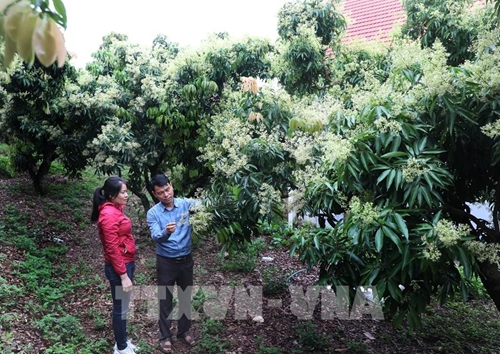Accordingly, the province will promote large-scale concentrated fruit growing areas with high quality, satisfying VietGAP and GlobalGAP standards, with the volume of lychee qualified for export will account for 70% of the total output. It will strive to boost the export of such products as pomelo, longan and custard apple to new markets, including the United States, the European Union and Japan.
    |
 |
|
Planting lychees in Bac Giang. (Photo for illustration) |
The province will ensure long-term food security and expand the cultivation of high-quality rice varieties which are expected to make up 50% of the planting area. Concentrated production zones for processed and safe vegetables will be set up along with the application of high technology.
Attention will be paid to developing large-scale concentrated farm husbandry associated with the building of disease-free facilities. Bac Giang's pork and chicken products qualify for domestic consumption and export.
The province will expand concentrated intensive fish farming and encourage the development of large-scale aquaculture farms.
It will promote the expansion of acacia growing areas while reducing the area of eucalyptus as well as encourage the plantation of large timber. Bac Giang strives to produce over 1 million cubic metres of timber by 2025, with a large timber forest area of 15,000 ha. The forest area granted the forest stewardship council (FSC) certificates will reach 12%.
The official pointed out shortcomings in the agricultural development of the province, including low labour productivity and high input costs.
The application of advanced technology and mechanisation in the production, harvesting, processing and preservation of agricultural products has not yet met export standards, especially in choosy markets, Tung said, adding that most of the province’s agricultural products are in the raw form so the added value is low.
In the future, Bac Giang will focus investment on key products, aiming to increase the combined value of the seven key products by an average of 5% a year.
Priority will be given to applying advanced technology, replicating green and circular economy and ecological agriculture models to improve the efficiency of natural resources.
Attention will be paid to promoting digital transformation in the agricultural sector, developing QR codes to facilitate the sales of farm produce via online commercial platforms, and using drones to spray pesticides and sow seeds.
According to the provincial Department of Agriculture and Rural Development, the growth of agricultural sector reached 1.4% per year in the 2016-2021 period. Its agricultural structure has shifted towards promoting its advantages and meeting the demand of the market. The proportion of cultivation, livestock breeding and agricultural services accounted for 55.7%, 43.2% and 2%, respectively.
The local agro-forestry-fishery sector has been growing at an average of 2.8% a year since 2016, reaching 21.6 trillion VND (922 million USD) in 2021. The province's average production value of a hectare of agricultural land was 135 million VND in 2021.
The value of agricultural production increased by 2.7% in the first six months of this year, obtaining nearly 20 trillion VND, equivalent to 50.9% of the yearly plan. It contributed 0.4 percentage points to the province's gross regional domestic product (GRDP).
The province will strive for annual growth of 3% in the added value of agro-fishery-forestry products by 2025. The average production value per one hectare of agricultural land is projected at 140 million VND a year. The value of agro-fishery-forestry products produced by cooperatives and other forms of production linkages should account for 20% of the province’s total value of those products.
The value of high-technology products should also account for 20% of the total in the period.
Source: VNA